Good Leadership Practices in Hong Kong Engineering Companies: A Study
VerifiedAdded on 2019/09/23
|25
|8703
|293
Project
AI Summary
This project investigates good leadership practices within Hong Kong's engineering companies, focusing on the perspectives of local employees aged 30 to 40. The research addresses the backdrop of a potential boom in the engineering and construction industry and the associated skilled labor shortage. The study aims to identify how employees perceive leadership, exploring whether company management impacts the labor shortage. The research includes a literature review, survey-based primary research with at least 30 respondents, and qualitative interviews with middle management. It seeks to identify 'good leadership practices' as viewed by employees to inform strategies for attracting and retaining talent. The project will outline the research approach, design, data collection methods, and ethical considerations, followed by an analysis of results and the implications of the findings. A Gantt chart for project planning and a conclusion summarizing the assumptions, limitations, and potential for further research are also included.
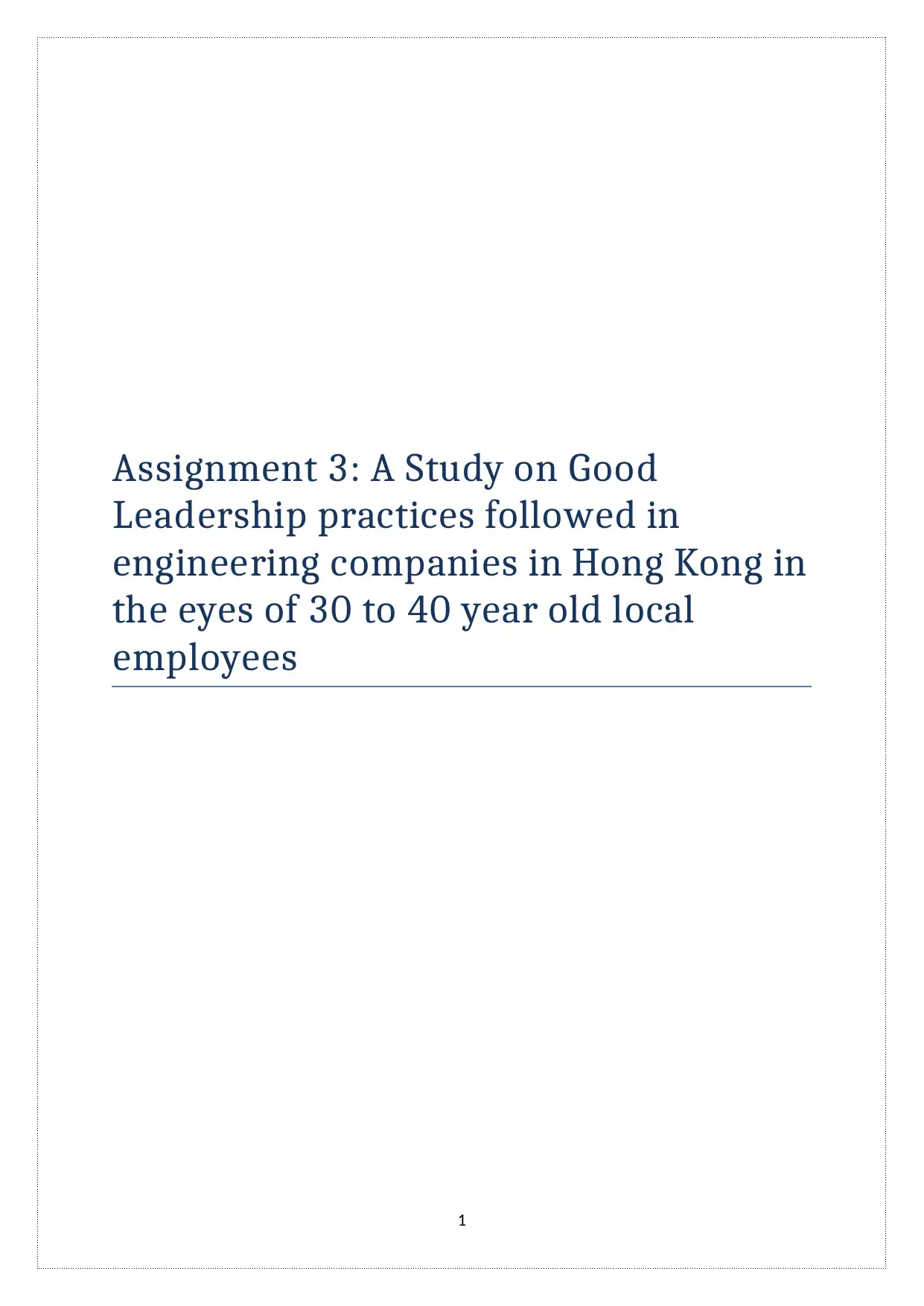
Assignment 3: A Study on Good
Leadership practices followed in
engineering companies in Hong Kong in
the eyes of 30 to 40 year old local
employees
1
Leadership practices followed in
engineering companies in Hong Kong in
the eyes of 30 to 40 year old local
employees
1
Paraphrase This Document
Need a fresh take? Get an instant paraphrase of this document with our AI Paraphraser
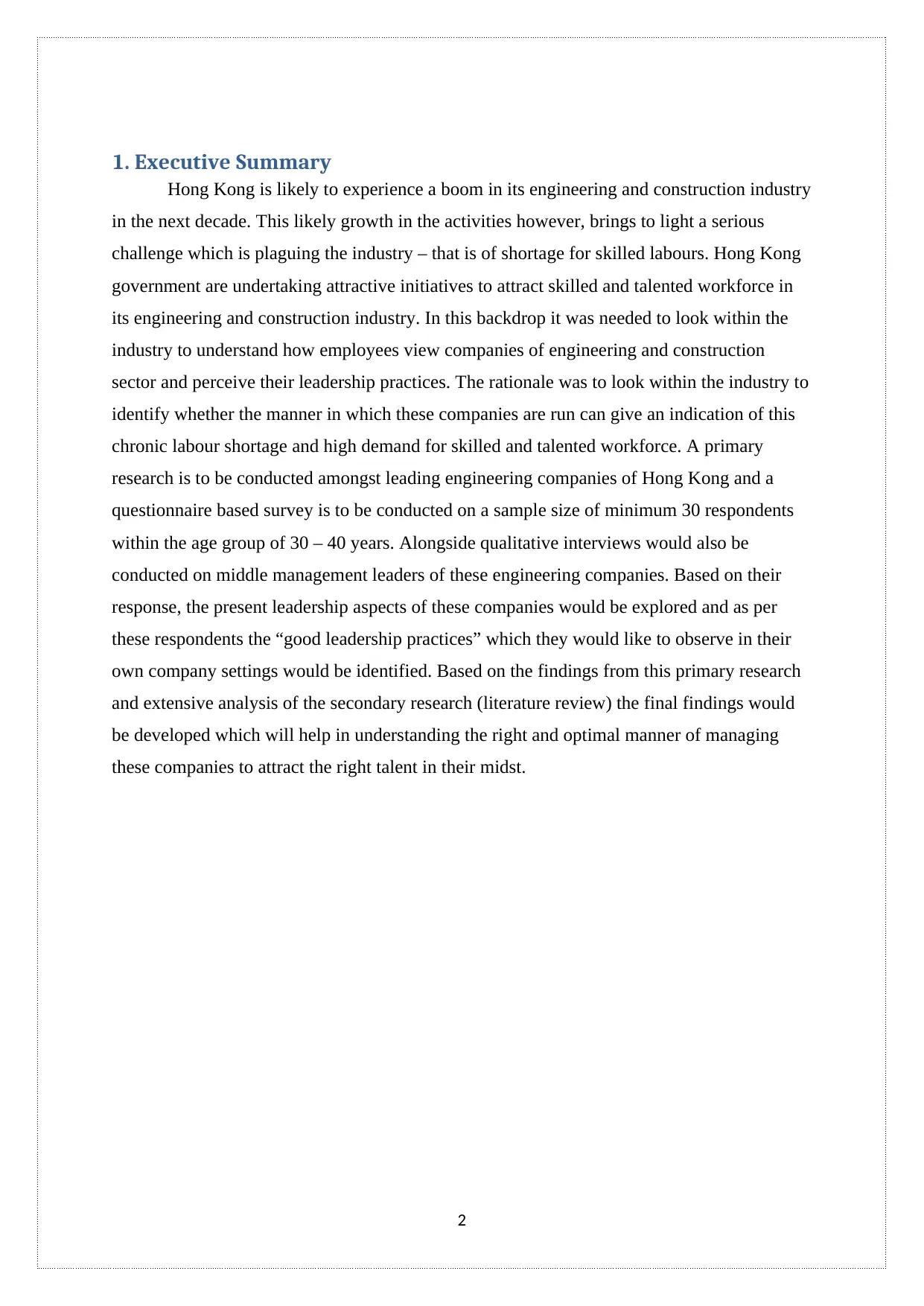
1. Executive Summary
Hong Kong is likely to experience a boom in its engineering and construction industry
in the next decade. This likely growth in the activities however, brings to light a serious
challenge which is plaguing the industry – that is of shortage for skilled labours. Hong Kong
government are undertaking attractive initiatives to attract skilled and talented workforce in
its engineering and construction industry. In this backdrop it was needed to look within the
industry to understand how employees view companies of engineering and construction
sector and perceive their leadership practices. The rationale was to look within the industry to
identify whether the manner in which these companies are run can give an indication of this
chronic labour shortage and high demand for skilled and talented workforce. A primary
research is to be conducted amongst leading engineering companies of Hong Kong and a
questionnaire based survey is to be conducted on a sample size of minimum 30 respondents
within the age group of 30 – 40 years. Alongside qualitative interviews would also be
conducted on middle management leaders of these engineering companies. Based on their
response, the present leadership aspects of these companies would be explored and as per
these respondents the “good leadership practices” which they would like to observe in their
own company settings would be identified. Based on the findings from this primary research
and extensive analysis of the secondary research (literature review) the final findings would
be developed which will help in understanding the right and optimal manner of managing
these companies to attract the right talent in their midst.
2
Hong Kong is likely to experience a boom in its engineering and construction industry
in the next decade. This likely growth in the activities however, brings to light a serious
challenge which is plaguing the industry – that is of shortage for skilled labours. Hong Kong
government are undertaking attractive initiatives to attract skilled and talented workforce in
its engineering and construction industry. In this backdrop it was needed to look within the
industry to understand how employees view companies of engineering and construction
sector and perceive their leadership practices. The rationale was to look within the industry to
identify whether the manner in which these companies are run can give an indication of this
chronic labour shortage and high demand for skilled and talented workforce. A primary
research is to be conducted amongst leading engineering companies of Hong Kong and a
questionnaire based survey is to be conducted on a sample size of minimum 30 respondents
within the age group of 30 – 40 years. Alongside qualitative interviews would also be
conducted on middle management leaders of these engineering companies. Based on their
response, the present leadership aspects of these companies would be explored and as per
these respondents the “good leadership practices” which they would like to observe in their
own company settings would be identified. Based on the findings from this primary research
and extensive analysis of the secondary research (literature review) the final findings would
be developed which will help in understanding the right and optimal manner of managing
these companies to attract the right talent in their midst.
2
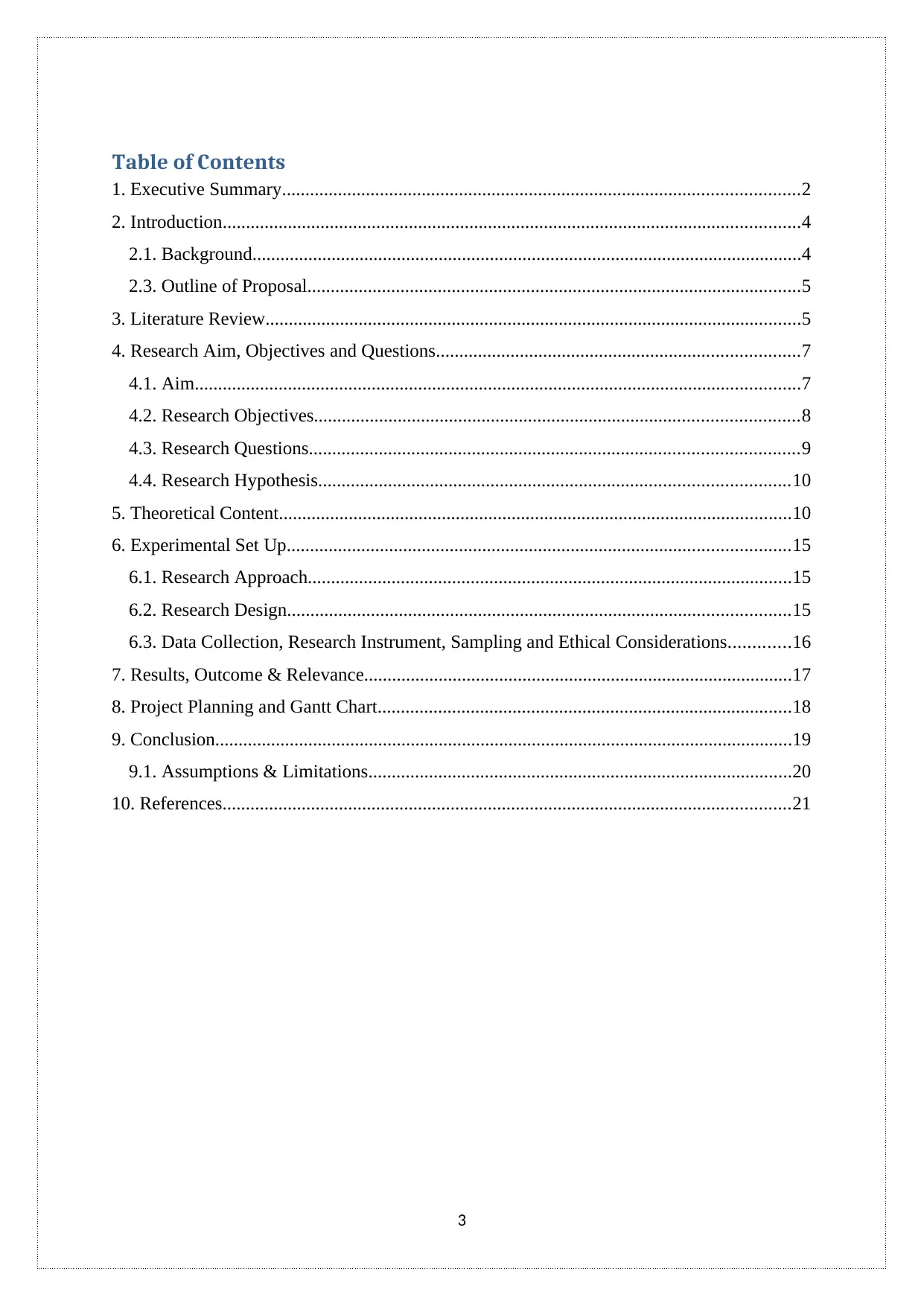
Table of Contents
1. Executive Summary...............................................................................................................2
2. Introduction............................................................................................................................4
2.1. Background......................................................................................................................4
2.3. Outline of Proposal..........................................................................................................5
3. Literature Review...................................................................................................................5
4. Research Aim, Objectives and Questions..............................................................................7
4.1. Aim..................................................................................................................................7
4.2. Research Objectives........................................................................................................8
4.3. Research Questions.........................................................................................................9
4.4. Research Hypothesis.....................................................................................................10
5. Theoretical Content..............................................................................................................10
6. Experimental Set Up............................................................................................................15
6.1. Research Approach........................................................................................................15
6.2. Research Design............................................................................................................15
6.3. Data Collection, Research Instrument, Sampling and Ethical Considerations.............16
7. Results, Outcome & Relevance............................................................................................17
8. Project Planning and Gantt Chart.........................................................................................18
9. Conclusion............................................................................................................................19
9.1. Assumptions & Limitations...........................................................................................20
10. References..........................................................................................................................21
3
1. Executive Summary...............................................................................................................2
2. Introduction............................................................................................................................4
2.1. Background......................................................................................................................4
2.3. Outline of Proposal..........................................................................................................5
3. Literature Review...................................................................................................................5
4. Research Aim, Objectives and Questions..............................................................................7
4.1. Aim..................................................................................................................................7
4.2. Research Objectives........................................................................................................8
4.3. Research Questions.........................................................................................................9
4.4. Research Hypothesis.....................................................................................................10
5. Theoretical Content..............................................................................................................10
6. Experimental Set Up............................................................................................................15
6.1. Research Approach........................................................................................................15
6.2. Research Design............................................................................................................15
6.3. Data Collection, Research Instrument, Sampling and Ethical Considerations.............16
7. Results, Outcome & Relevance............................................................................................17
8. Project Planning and Gantt Chart.........................................................................................18
9. Conclusion............................................................................................................................19
9.1. Assumptions & Limitations...........................................................................................20
10. References..........................................................................................................................21
3
⊘ This is a preview!⊘
Do you want full access?
Subscribe today to unlock all pages.

Trusted by 1+ million students worldwide
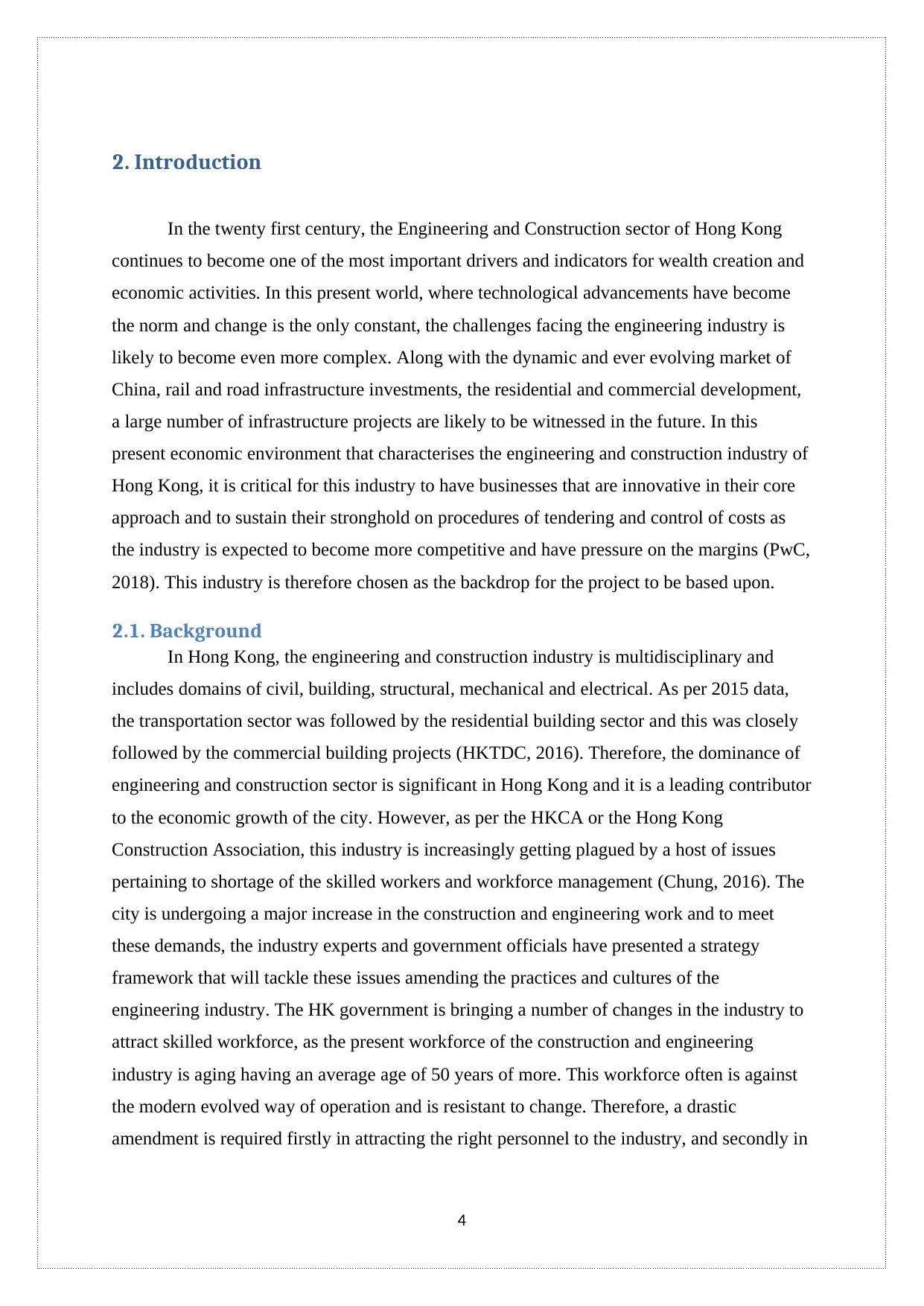
2. Introduction
In the twenty first century, the Engineering and Construction sector of Hong Kong
continues to become one of the most important drivers and indicators for wealth creation and
economic activities. In this present world, where technological advancements have become
the norm and change is the only constant, the challenges facing the engineering industry is
likely to become even more complex. Along with the dynamic and ever evolving market of
China, rail and road infrastructure investments, the residential and commercial development,
a large number of infrastructure projects are likely to be witnessed in the future. In this
present economic environment that characterises the engineering and construction industry of
Hong Kong, it is critical for this industry to have businesses that are innovative in their core
approach and to sustain their stronghold on procedures of tendering and control of costs as
the industry is expected to become more competitive and have pressure on the margins (PwC,
2018). This industry is therefore chosen as the backdrop for the project to be based upon.
2.1. Background
In Hong Kong, the engineering and construction industry is multidisciplinary and
includes domains of civil, building, structural, mechanical and electrical. As per 2015 data,
the transportation sector was followed by the residential building sector and this was closely
followed by the commercial building projects (HKTDC, 2016). Therefore, the dominance of
engineering and construction sector is significant in Hong Kong and it is a leading contributor
to the economic growth of the city. However, as per the HKCA or the Hong Kong
Construction Association, this industry is increasingly getting plagued by a host of issues
pertaining to shortage of the skilled workers and workforce management (Chung, 2016). The
city is undergoing a major increase in the construction and engineering work and to meet
these demands, the industry experts and government officials have presented a strategy
framework that will tackle these issues amending the practices and cultures of the
engineering industry. The HK government is bringing a number of changes in the industry to
attract skilled workforce, as the present workforce of the construction and engineering
industry is aging having an average age of 50 years of more. This workforce often is against
the modern evolved way of operation and is resistant to change. Therefore, a drastic
amendment is required firstly in attracting the right personnel to the industry, and secondly in
4
In the twenty first century, the Engineering and Construction sector of Hong Kong
continues to become one of the most important drivers and indicators for wealth creation and
economic activities. In this present world, where technological advancements have become
the norm and change is the only constant, the challenges facing the engineering industry is
likely to become even more complex. Along with the dynamic and ever evolving market of
China, rail and road infrastructure investments, the residential and commercial development,
a large number of infrastructure projects are likely to be witnessed in the future. In this
present economic environment that characterises the engineering and construction industry of
Hong Kong, it is critical for this industry to have businesses that are innovative in their core
approach and to sustain their stronghold on procedures of tendering and control of costs as
the industry is expected to become more competitive and have pressure on the margins (PwC,
2018). This industry is therefore chosen as the backdrop for the project to be based upon.
2.1. Background
In Hong Kong, the engineering and construction industry is multidisciplinary and
includes domains of civil, building, structural, mechanical and electrical. As per 2015 data,
the transportation sector was followed by the residential building sector and this was closely
followed by the commercial building projects (HKTDC, 2016). Therefore, the dominance of
engineering and construction sector is significant in Hong Kong and it is a leading contributor
to the economic growth of the city. However, as per the HKCA or the Hong Kong
Construction Association, this industry is increasingly getting plagued by a host of issues
pertaining to shortage of the skilled workers and workforce management (Chung, 2016). The
city is undergoing a major increase in the construction and engineering work and to meet
these demands, the industry experts and government officials have presented a strategy
framework that will tackle these issues amending the practices and cultures of the
engineering industry. The HK government is bringing a number of changes in the industry to
attract skilled workforce, as the present workforce of the construction and engineering
industry is aging having an average age of 50 years of more. This workforce often is against
the modern evolved way of operation and is resistant to change. Therefore, a drastic
amendment is required firstly in attracting the right personnel to the industry, and secondly in
4
Paraphrase This Document
Need a fresh take? Get an instant paraphrase of this document with our AI Paraphraser
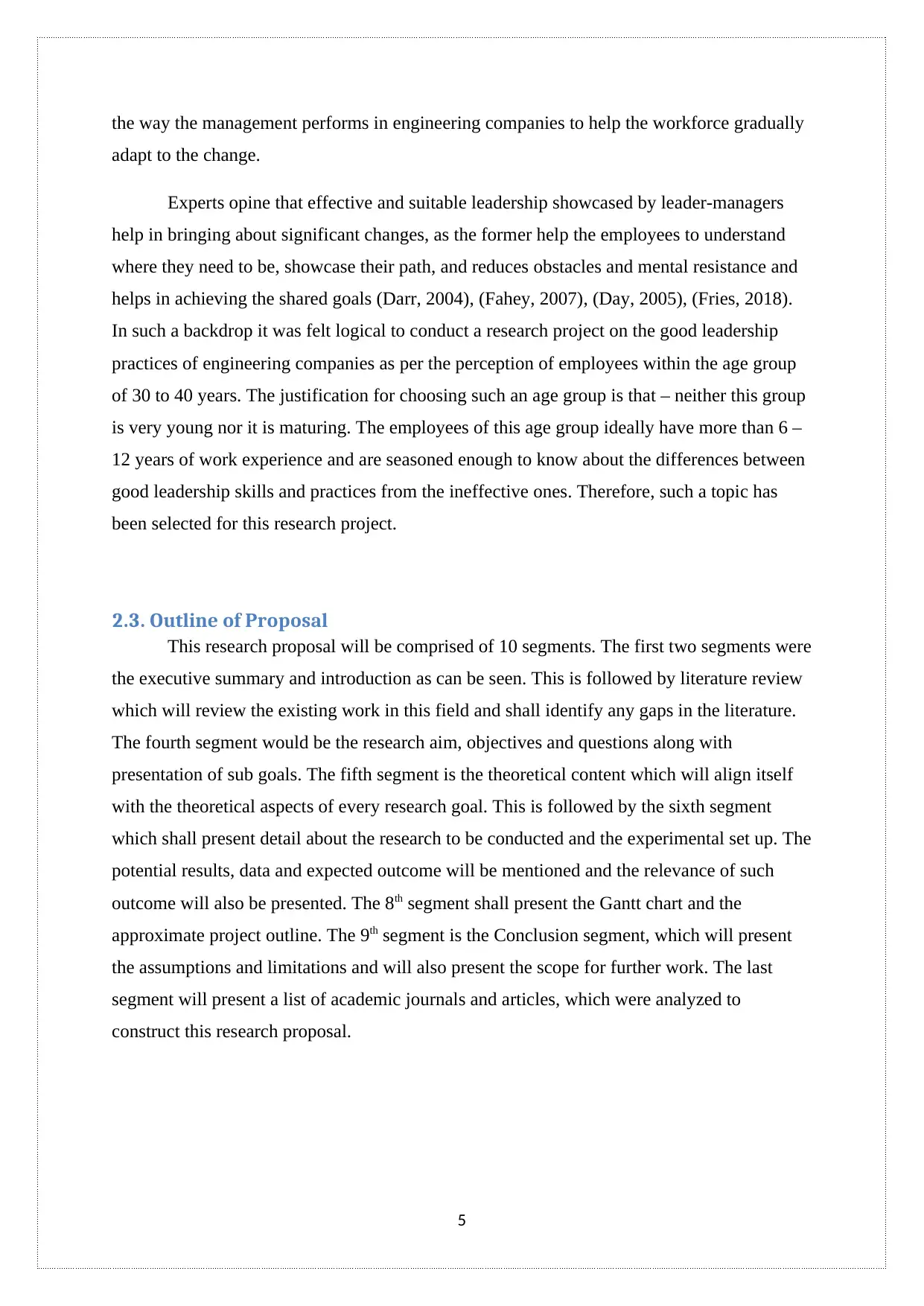
the way the management performs in engineering companies to help the workforce gradually
adapt to the change.
Experts opine that effective and suitable leadership showcased by leader-managers
help in bringing about significant changes, as the former help the employees to understand
where they need to be, showcase their path, and reduces obstacles and mental resistance and
helps in achieving the shared goals (Darr, 2004), (Fahey, 2007), (Day, 2005), (Fries, 2018).
In such a backdrop it was felt logical to conduct a research project on the good leadership
practices of engineering companies as per the perception of employees within the age group
of 30 to 40 years. The justification for choosing such an age group is that – neither this group
is very young nor it is maturing. The employees of this age group ideally have more than 6 –
12 years of work experience and are seasoned enough to know about the differences between
good leadership skills and practices from the ineffective ones. Therefore, such a topic has
been selected for this research project.
2.3. Outline of Proposal
This research proposal will be comprised of 10 segments. The first two segments were
the executive summary and introduction as can be seen. This is followed by literature review
which will review the existing work in this field and shall identify any gaps in the literature.
The fourth segment would be the research aim, objectives and questions along with
presentation of sub goals. The fifth segment is the theoretical content which will align itself
with the theoretical aspects of every research goal. This is followed by the sixth segment
which shall present detail about the research to be conducted and the experimental set up. The
potential results, data and expected outcome will be mentioned and the relevance of such
outcome will also be presented. The 8th segment shall present the Gantt chart and the
approximate project outline. The 9th segment is the Conclusion segment, which will present
the assumptions and limitations and will also present the scope for further work. The last
segment will present a list of academic journals and articles, which were analyzed to
construct this research proposal.
5
adapt to the change.
Experts opine that effective and suitable leadership showcased by leader-managers
help in bringing about significant changes, as the former help the employees to understand
where they need to be, showcase their path, and reduces obstacles and mental resistance and
helps in achieving the shared goals (Darr, 2004), (Fahey, 2007), (Day, 2005), (Fries, 2018).
In such a backdrop it was felt logical to conduct a research project on the good leadership
practices of engineering companies as per the perception of employees within the age group
of 30 to 40 years. The justification for choosing such an age group is that – neither this group
is very young nor it is maturing. The employees of this age group ideally have more than 6 –
12 years of work experience and are seasoned enough to know about the differences between
good leadership skills and practices from the ineffective ones. Therefore, such a topic has
been selected for this research project.
2.3. Outline of Proposal
This research proposal will be comprised of 10 segments. The first two segments were
the executive summary and introduction as can be seen. This is followed by literature review
which will review the existing work in this field and shall identify any gaps in the literature.
The fourth segment would be the research aim, objectives and questions along with
presentation of sub goals. The fifth segment is the theoretical content which will align itself
with the theoretical aspects of every research goal. This is followed by the sixth segment
which shall present detail about the research to be conducted and the experimental set up. The
potential results, data and expected outcome will be mentioned and the relevance of such
outcome will also be presented. The 8th segment shall present the Gantt chart and the
approximate project outline. The 9th segment is the Conclusion segment, which will present
the assumptions and limitations and will also present the scope for further work. The last
segment will present a list of academic journals and articles, which were analyzed to
construct this research proposal.
5
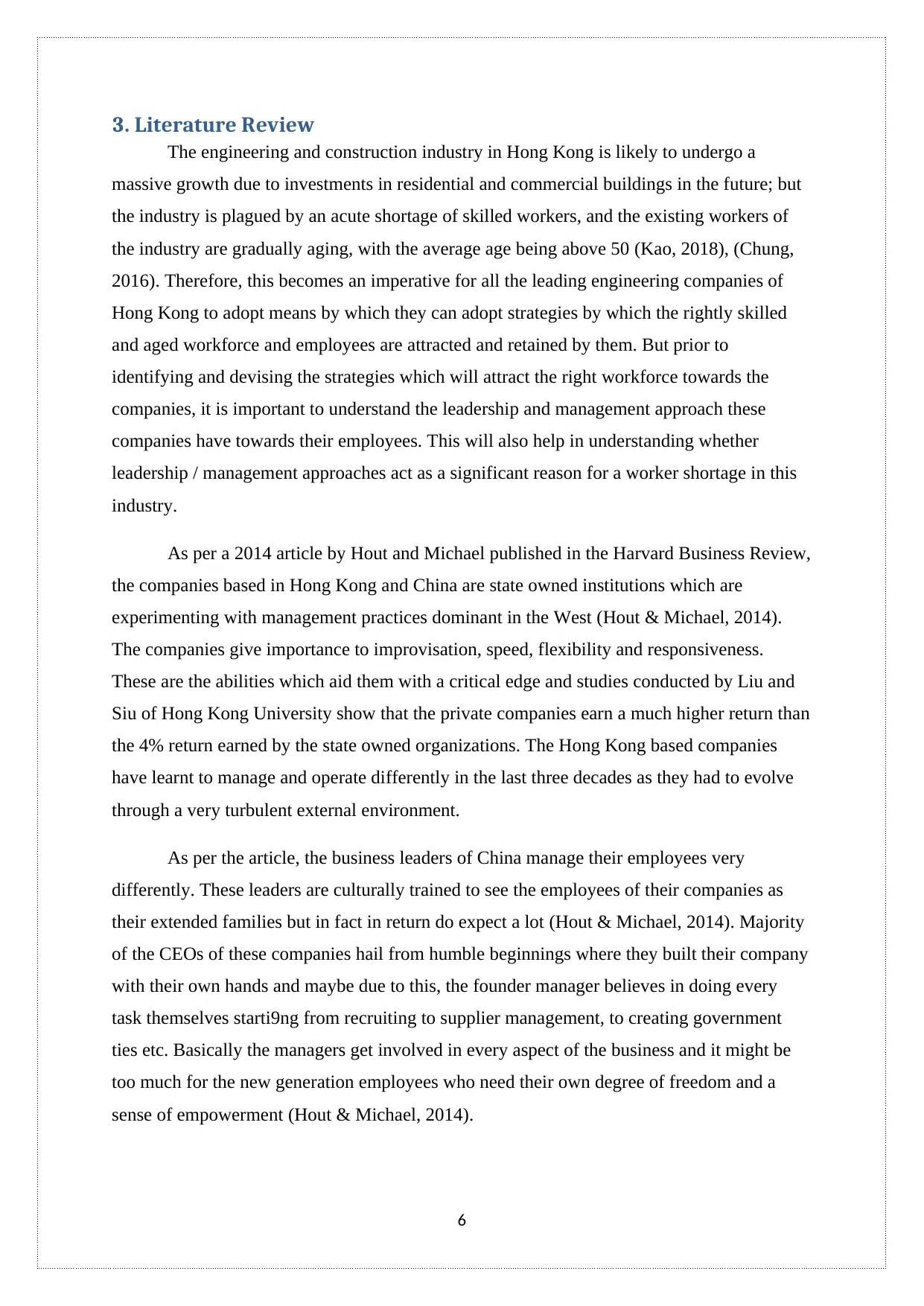
3. Literature Review
The engineering and construction industry in Hong Kong is likely to undergo a
massive growth due to investments in residential and commercial buildings in the future; but
the industry is plagued by an acute shortage of skilled workers, and the existing workers of
the industry are gradually aging, with the average age being above 50 (Kao, 2018), (Chung,
2016). Therefore, this becomes an imperative for all the leading engineering companies of
Hong Kong to adopt means by which they can adopt strategies by which the rightly skilled
and aged workforce and employees are attracted and retained by them. But prior to
identifying and devising the strategies which will attract the right workforce towards the
companies, it is important to understand the leadership and management approach these
companies have towards their employees. This will also help in understanding whether
leadership / management approaches act as a significant reason for a worker shortage in this
industry.
As per a 2014 article by Hout and Michael published in the Harvard Business Review,
the companies based in Hong Kong and China are state owned institutions which are
experimenting with management practices dominant in the West (Hout & Michael, 2014).
The companies give importance to improvisation, speed, flexibility and responsiveness.
These are the abilities which aid them with a critical edge and studies conducted by Liu and
Siu of Hong Kong University show that the private companies earn a much higher return than
the 4% return earned by the state owned organizations. The Hong Kong based companies
have learnt to manage and operate differently in the last three decades as they had to evolve
through a very turbulent external environment.
As per the article, the business leaders of China manage their employees very
differently. These leaders are culturally trained to see the employees of their companies as
their extended families but in fact in return do expect a lot (Hout & Michael, 2014). Majority
of the CEOs of these companies hail from humble beginnings where they built their company
with their own hands and maybe due to this, the founder manager believes in doing every
task themselves starti9ng from recruiting to supplier management, to creating government
ties etc. Basically the managers get involved in every aspect of the business and it might be
too much for the new generation employees who need their own degree of freedom and a
sense of empowerment (Hout & Michael, 2014).
6
The engineering and construction industry in Hong Kong is likely to undergo a
massive growth due to investments in residential and commercial buildings in the future; but
the industry is plagued by an acute shortage of skilled workers, and the existing workers of
the industry are gradually aging, with the average age being above 50 (Kao, 2018), (Chung,
2016). Therefore, this becomes an imperative for all the leading engineering companies of
Hong Kong to adopt means by which they can adopt strategies by which the rightly skilled
and aged workforce and employees are attracted and retained by them. But prior to
identifying and devising the strategies which will attract the right workforce towards the
companies, it is important to understand the leadership and management approach these
companies have towards their employees. This will also help in understanding whether
leadership / management approaches act as a significant reason for a worker shortage in this
industry.
As per a 2014 article by Hout and Michael published in the Harvard Business Review,
the companies based in Hong Kong and China are state owned institutions which are
experimenting with management practices dominant in the West (Hout & Michael, 2014).
The companies give importance to improvisation, speed, flexibility and responsiveness.
These are the abilities which aid them with a critical edge and studies conducted by Liu and
Siu of Hong Kong University show that the private companies earn a much higher return than
the 4% return earned by the state owned organizations. The Hong Kong based companies
have learnt to manage and operate differently in the last three decades as they had to evolve
through a very turbulent external environment.
As per the article, the business leaders of China manage their employees very
differently. These leaders are culturally trained to see the employees of their companies as
their extended families but in fact in return do expect a lot (Hout & Michael, 2014). Majority
of the CEOs of these companies hail from humble beginnings where they built their company
with their own hands and maybe due to this, the founder manager believes in doing every
task themselves starti9ng from recruiting to supplier management, to creating government
ties etc. Basically the managers get involved in every aspect of the business and it might be
too much for the new generation employees who need their own degree of freedom and a
sense of empowerment (Hout & Michael, 2014).
6
⊘ This is a preview!⊘
Do you want full access?
Subscribe today to unlock all pages.

Trusted by 1+ million students worldwide
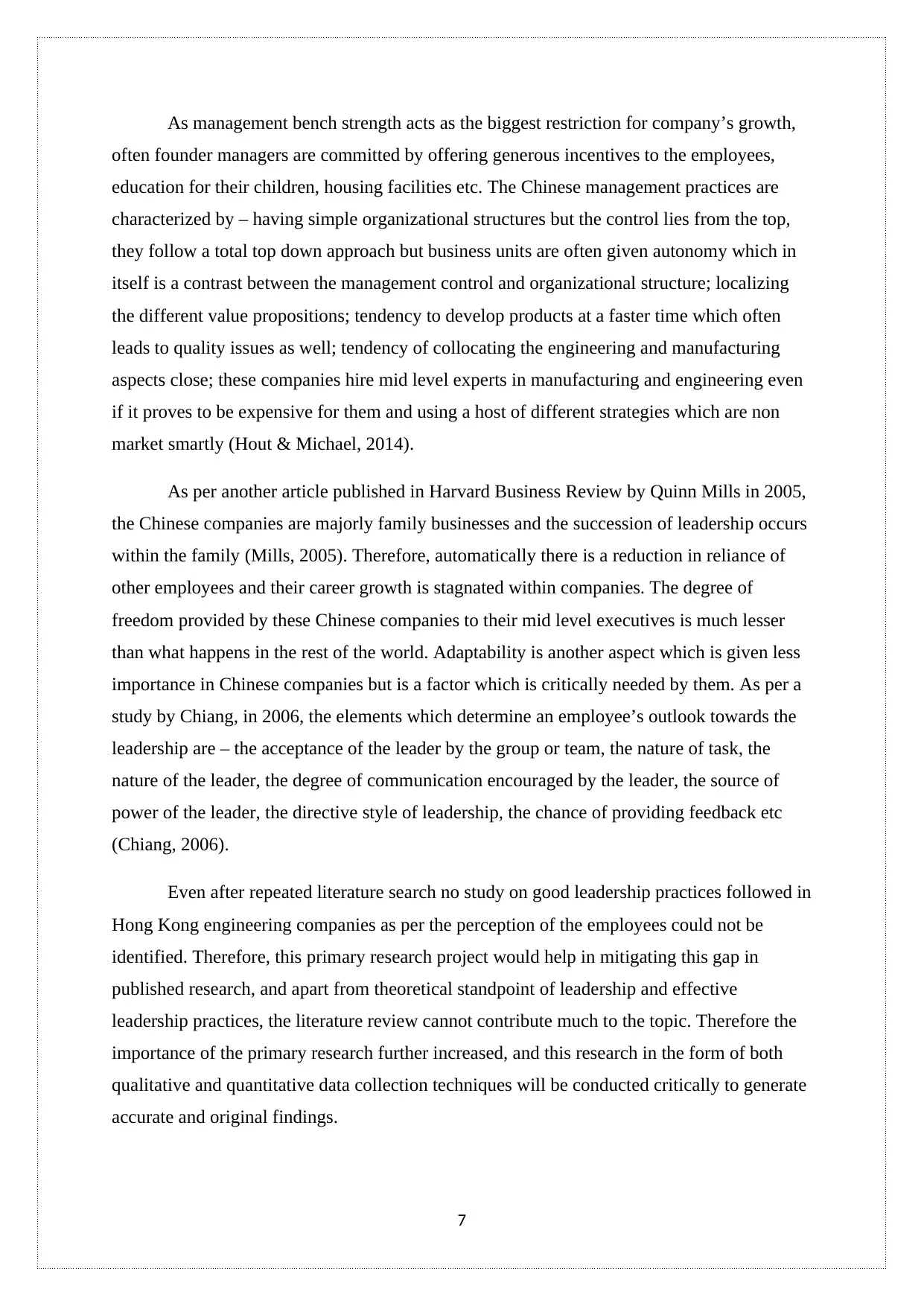
As management bench strength acts as the biggest restriction for company’s growth,
often founder managers are committed by offering generous incentives to the employees,
education for their children, housing facilities etc. The Chinese management practices are
characterized by – having simple organizational structures but the control lies from the top,
they follow a total top down approach but business units are often given autonomy which in
itself is a contrast between the management control and organizational structure; localizing
the different value propositions; tendency to develop products at a faster time which often
leads to quality issues as well; tendency of collocating the engineering and manufacturing
aspects close; these companies hire mid level experts in manufacturing and engineering even
if it proves to be expensive for them and using a host of different strategies which are non
market smartly (Hout & Michael, 2014).
As per another article published in Harvard Business Review by Quinn Mills in 2005,
the Chinese companies are majorly family businesses and the succession of leadership occurs
within the family (Mills, 2005). Therefore, automatically there is a reduction in reliance of
other employees and their career growth is stagnated within companies. The degree of
freedom provided by these Chinese companies to their mid level executives is much lesser
than what happens in the rest of the world. Adaptability is another aspect which is given less
importance in Chinese companies but is a factor which is critically needed by them. As per a
study by Chiang, in 2006, the elements which determine an employee’s outlook towards the
leadership are – the acceptance of the leader by the group or team, the nature of task, the
nature of the leader, the degree of communication encouraged by the leader, the source of
power of the leader, the directive style of leadership, the chance of providing feedback etc
(Chiang, 2006).
Even after repeated literature search no study on good leadership practices followed in
Hong Kong engineering companies as per the perception of the employees could not be
identified. Therefore, this primary research project would help in mitigating this gap in
published research, and apart from theoretical standpoint of leadership and effective
leadership practices, the literature review cannot contribute much to the topic. Therefore the
importance of the primary research further increased, and this research in the form of both
qualitative and quantitative data collection techniques will be conducted critically to generate
accurate and original findings.
7
often founder managers are committed by offering generous incentives to the employees,
education for their children, housing facilities etc. The Chinese management practices are
characterized by – having simple organizational structures but the control lies from the top,
they follow a total top down approach but business units are often given autonomy which in
itself is a contrast between the management control and organizational structure; localizing
the different value propositions; tendency to develop products at a faster time which often
leads to quality issues as well; tendency of collocating the engineering and manufacturing
aspects close; these companies hire mid level experts in manufacturing and engineering even
if it proves to be expensive for them and using a host of different strategies which are non
market smartly (Hout & Michael, 2014).
As per another article published in Harvard Business Review by Quinn Mills in 2005,
the Chinese companies are majorly family businesses and the succession of leadership occurs
within the family (Mills, 2005). Therefore, automatically there is a reduction in reliance of
other employees and their career growth is stagnated within companies. The degree of
freedom provided by these Chinese companies to their mid level executives is much lesser
than what happens in the rest of the world. Adaptability is another aspect which is given less
importance in Chinese companies but is a factor which is critically needed by them. As per a
study by Chiang, in 2006, the elements which determine an employee’s outlook towards the
leadership are – the acceptance of the leader by the group or team, the nature of task, the
nature of the leader, the degree of communication encouraged by the leader, the source of
power of the leader, the directive style of leadership, the chance of providing feedback etc
(Chiang, 2006).
Even after repeated literature search no study on good leadership practices followed in
Hong Kong engineering companies as per the perception of the employees could not be
identified. Therefore, this primary research project would help in mitigating this gap in
published research, and apart from theoretical standpoint of leadership and effective
leadership practices, the literature review cannot contribute much to the topic. Therefore the
importance of the primary research further increased, and this research in the form of both
qualitative and quantitative data collection techniques will be conducted critically to generate
accurate and original findings.
7
Paraphrase This Document
Need a fresh take? Get an instant paraphrase of this document with our AI Paraphraser
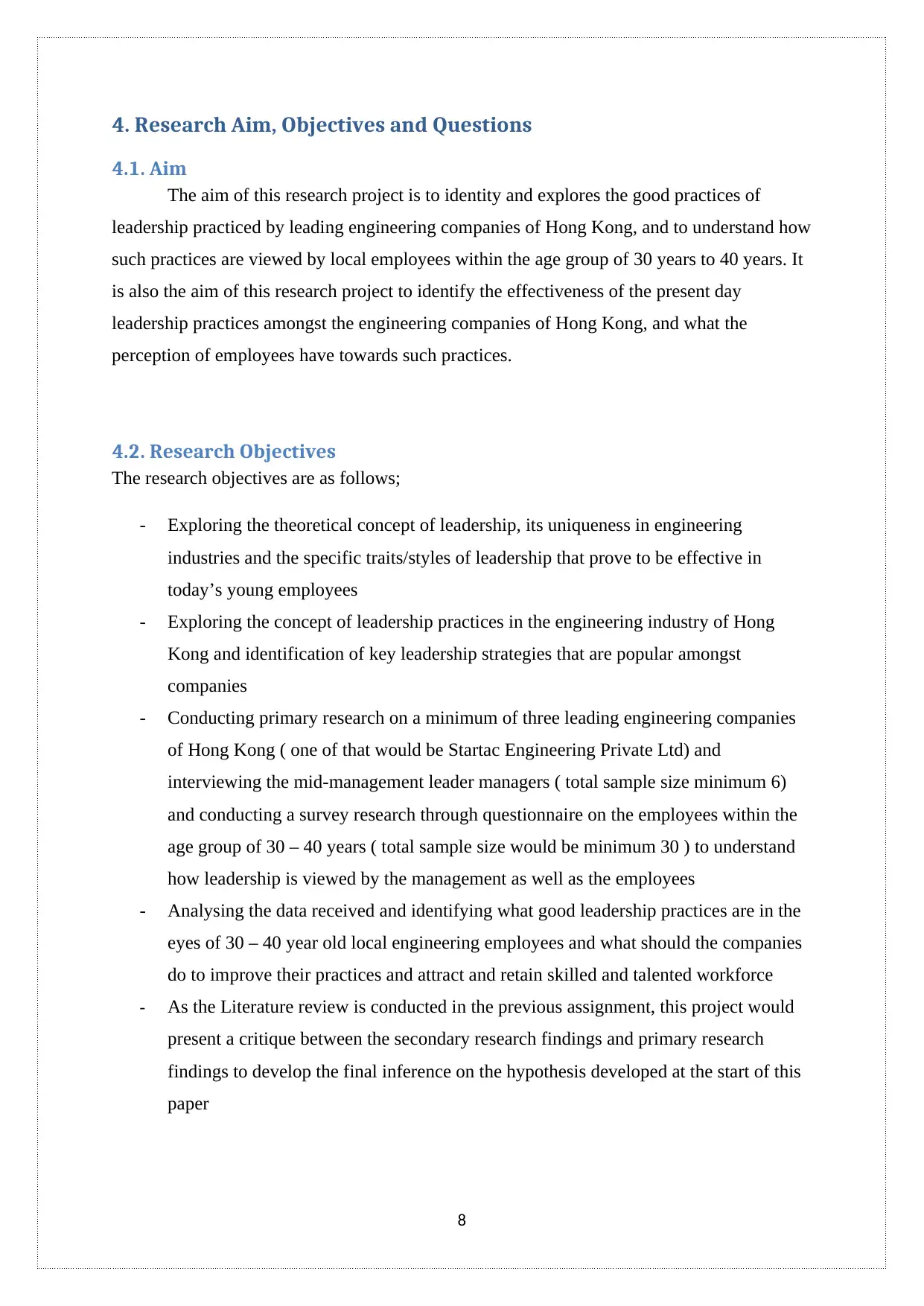
4. Research Aim, Objectives and Questions
4.1. Aim
The aim of this research project is to identity and explores the good practices of
leadership practiced by leading engineering companies of Hong Kong, and to understand how
such practices are viewed by local employees within the age group of 30 years to 40 years. It
is also the aim of this research project to identify the effectiveness of the present day
leadership practices amongst the engineering companies of Hong Kong, and what the
perception of employees have towards such practices.
4.2. Research Objectives
The research objectives are as follows;
- Exploring the theoretical concept of leadership, its uniqueness in engineering
industries and the specific traits/styles of leadership that prove to be effective in
today’s young employees
- Exploring the concept of leadership practices in the engineering industry of Hong
Kong and identification of key leadership strategies that are popular amongst
companies
- Conducting primary research on a minimum of three leading engineering companies
of Hong Kong ( one of that would be Startac Engineering Private Ltd) and
interviewing the mid-management leader managers ( total sample size minimum 6)
and conducting a survey research through questionnaire on the employees within the
age group of 30 – 40 years ( total sample size would be minimum 30 ) to understand
how leadership is viewed by the management as well as the employees
- Analysing the data received and identifying what good leadership practices are in the
eyes of 30 – 40 year old local engineering employees and what should the companies
do to improve their practices and attract and retain skilled and talented workforce
- As the Literature review is conducted in the previous assignment, this project would
present a critique between the secondary research findings and primary research
findings to develop the final inference on the hypothesis developed at the start of this
paper
8
4.1. Aim
The aim of this research project is to identity and explores the good practices of
leadership practiced by leading engineering companies of Hong Kong, and to understand how
such practices are viewed by local employees within the age group of 30 years to 40 years. It
is also the aim of this research project to identify the effectiveness of the present day
leadership practices amongst the engineering companies of Hong Kong, and what the
perception of employees have towards such practices.
4.2. Research Objectives
The research objectives are as follows;
- Exploring the theoretical concept of leadership, its uniqueness in engineering
industries and the specific traits/styles of leadership that prove to be effective in
today’s young employees
- Exploring the concept of leadership practices in the engineering industry of Hong
Kong and identification of key leadership strategies that are popular amongst
companies
- Conducting primary research on a minimum of three leading engineering companies
of Hong Kong ( one of that would be Startac Engineering Private Ltd) and
interviewing the mid-management leader managers ( total sample size minimum 6)
and conducting a survey research through questionnaire on the employees within the
age group of 30 – 40 years ( total sample size would be minimum 30 ) to understand
how leadership is viewed by the management as well as the employees
- Analysing the data received and identifying what good leadership practices are in the
eyes of 30 – 40 year old local engineering employees and what should the companies
do to improve their practices and attract and retain skilled and talented workforce
- As the Literature review is conducted in the previous assignment, this project would
present a critique between the secondary research findings and primary research
findings to develop the final inference on the hypothesis developed at the start of this
paper
8
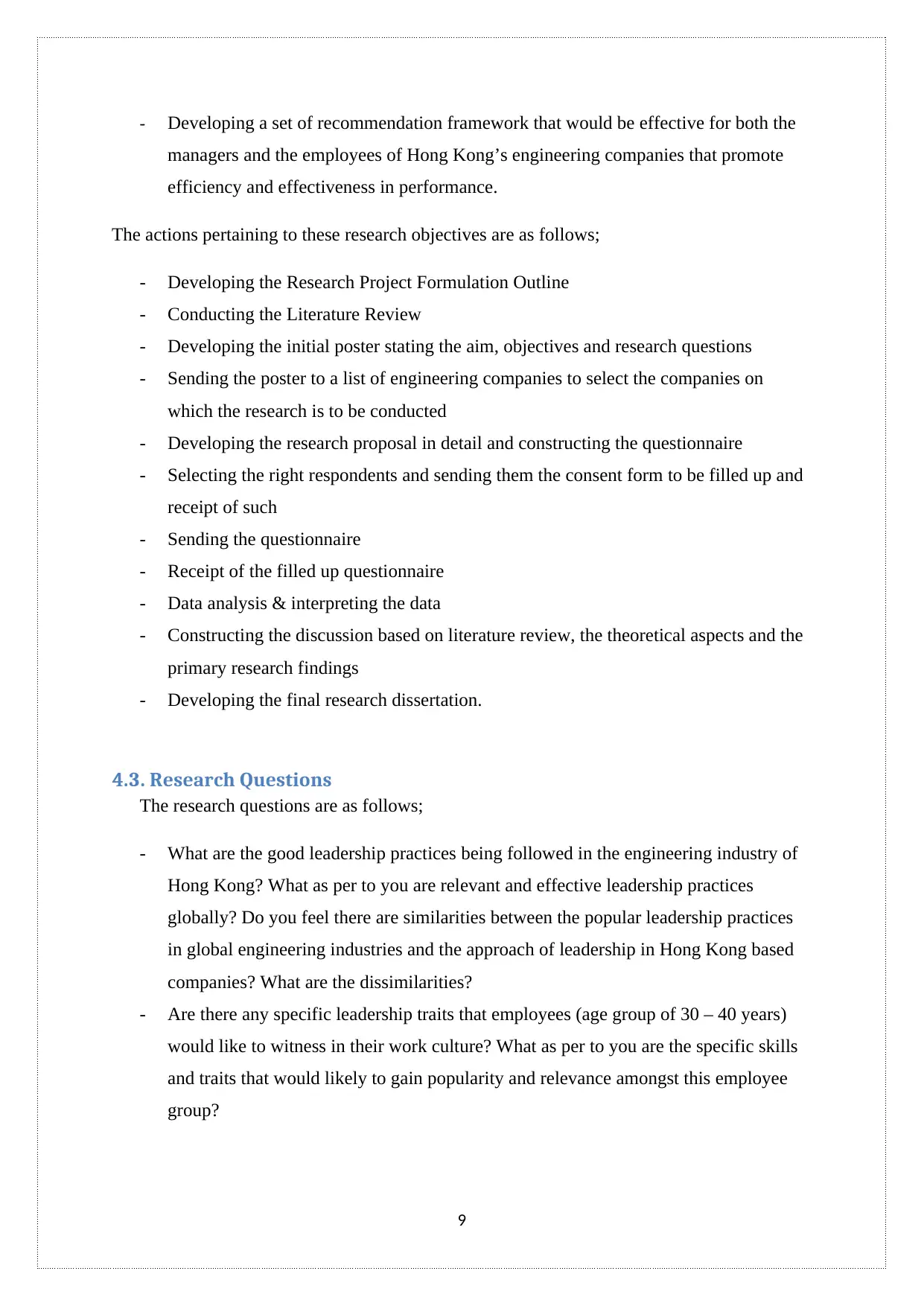
- Developing a set of recommendation framework that would be effective for both the
managers and the employees of Hong Kong’s engineering companies that promote
efficiency and effectiveness in performance.
The actions pertaining to these research objectives are as follows;
- Developing the Research Project Formulation Outline
- Conducting the Literature Review
- Developing the initial poster stating the aim, objectives and research questions
- Sending the poster to a list of engineering companies to select the companies on
which the research is to be conducted
- Developing the research proposal in detail and constructing the questionnaire
- Selecting the right respondents and sending them the consent form to be filled up and
receipt of such
- Sending the questionnaire
- Receipt of the filled up questionnaire
- Data analysis & interpreting the data
- Constructing the discussion based on literature review, the theoretical aspects and the
primary research findings
- Developing the final research dissertation.
4.3. Research Questions
The research questions are as follows;
- What are the good leadership practices being followed in the engineering industry of
Hong Kong? What as per to you are relevant and effective leadership practices
globally? Do you feel there are similarities between the popular leadership practices
in global engineering industries and the approach of leadership in Hong Kong based
companies? What are the dissimilarities?
- Are there any specific leadership traits that employees (age group of 30 – 40 years)
would like to witness in their work culture? What as per to you are the specific skills
and traits that would likely to gain popularity and relevance amongst this employee
group?
9
managers and the employees of Hong Kong’s engineering companies that promote
efficiency and effectiveness in performance.
The actions pertaining to these research objectives are as follows;
- Developing the Research Project Formulation Outline
- Conducting the Literature Review
- Developing the initial poster stating the aim, objectives and research questions
- Sending the poster to a list of engineering companies to select the companies on
which the research is to be conducted
- Developing the research proposal in detail and constructing the questionnaire
- Selecting the right respondents and sending them the consent form to be filled up and
receipt of such
- Sending the questionnaire
- Receipt of the filled up questionnaire
- Data analysis & interpreting the data
- Constructing the discussion based on literature review, the theoretical aspects and the
primary research findings
- Developing the final research dissertation.
4.3. Research Questions
The research questions are as follows;
- What are the good leadership practices being followed in the engineering industry of
Hong Kong? What as per to you are relevant and effective leadership practices
globally? Do you feel there are similarities between the popular leadership practices
in global engineering industries and the approach of leadership in Hong Kong based
companies? What are the dissimilarities?
- Are there any specific leadership traits that employees (age group of 30 – 40 years)
would like to witness in their work culture? What as per to you are the specific skills
and traits that would likely to gain popularity and relevance amongst this employee
group?
9
⊘ This is a preview!⊘
Do you want full access?
Subscribe today to unlock all pages.

Trusted by 1+ million students worldwide
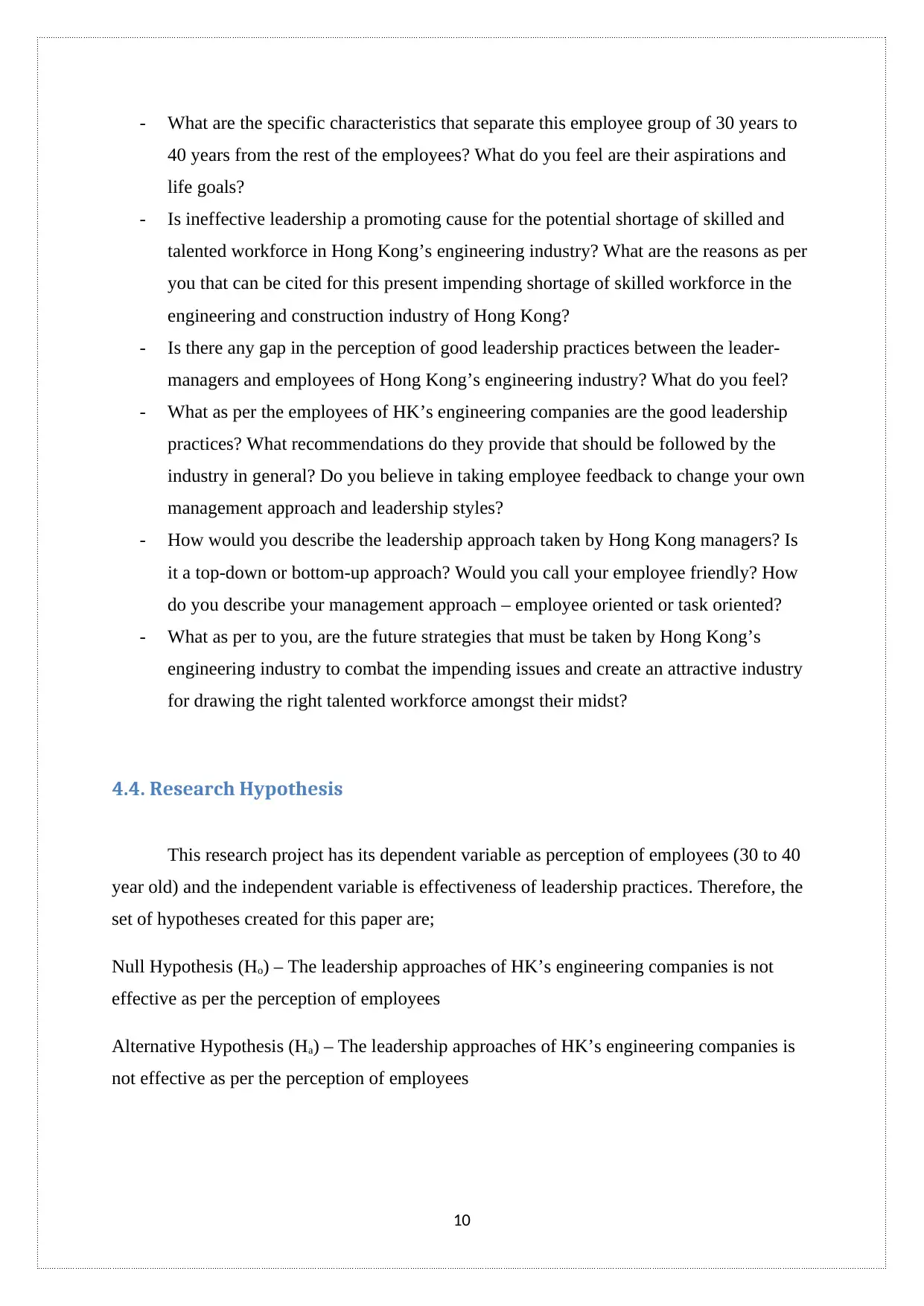
- What are the specific characteristics that separate this employee group of 30 years to
40 years from the rest of the employees? What do you feel are their aspirations and
life goals?
- Is ineffective leadership a promoting cause for the potential shortage of skilled and
talented workforce in Hong Kong’s engineering industry? What are the reasons as per
you that can be cited for this present impending shortage of skilled workforce in the
engineering and construction industry of Hong Kong?
- Is there any gap in the perception of good leadership practices between the leader-
managers and employees of Hong Kong’s engineering industry? What do you feel?
- What as per the employees of HK’s engineering companies are the good leadership
practices? What recommendations do they provide that should be followed by the
industry in general? Do you believe in taking employee feedback to change your own
management approach and leadership styles?
- How would you describe the leadership approach taken by Hong Kong managers? Is
it a top-down or bottom-up approach? Would you call your employee friendly? How
do you describe your management approach – employee oriented or task oriented?
- What as per to you, are the future strategies that must be taken by Hong Kong’s
engineering industry to combat the impending issues and create an attractive industry
for drawing the right talented workforce amongst their midst?
4.4. Research Hypothesis
This research project has its dependent variable as perception of employees (30 to 40
year old) and the independent variable is effectiveness of leadership practices. Therefore, the
set of hypotheses created for this paper are;
Null Hypothesis (Ho) – The leadership approaches of HK’s engineering companies is not
effective as per the perception of employees
Alternative Hypothesis (Ha) – The leadership approaches of HK’s engineering companies is
not effective as per the perception of employees
10
40 years from the rest of the employees? What do you feel are their aspirations and
life goals?
- Is ineffective leadership a promoting cause for the potential shortage of skilled and
talented workforce in Hong Kong’s engineering industry? What are the reasons as per
you that can be cited for this present impending shortage of skilled workforce in the
engineering and construction industry of Hong Kong?
- Is there any gap in the perception of good leadership practices between the leader-
managers and employees of Hong Kong’s engineering industry? What do you feel?
- What as per the employees of HK’s engineering companies are the good leadership
practices? What recommendations do they provide that should be followed by the
industry in general? Do you believe in taking employee feedback to change your own
management approach and leadership styles?
- How would you describe the leadership approach taken by Hong Kong managers? Is
it a top-down or bottom-up approach? Would you call your employee friendly? How
do you describe your management approach – employee oriented or task oriented?
- What as per to you, are the future strategies that must be taken by Hong Kong’s
engineering industry to combat the impending issues and create an attractive industry
for drawing the right talented workforce amongst their midst?
4.4. Research Hypothesis
This research project has its dependent variable as perception of employees (30 to 40
year old) and the independent variable is effectiveness of leadership practices. Therefore, the
set of hypotheses created for this paper are;
Null Hypothesis (Ho) – The leadership approaches of HK’s engineering companies is not
effective as per the perception of employees
Alternative Hypothesis (Ha) – The leadership approaches of HK’s engineering companies is
not effective as per the perception of employees
10
Paraphrase This Document
Need a fresh take? Get an instant paraphrase of this document with our AI Paraphraser
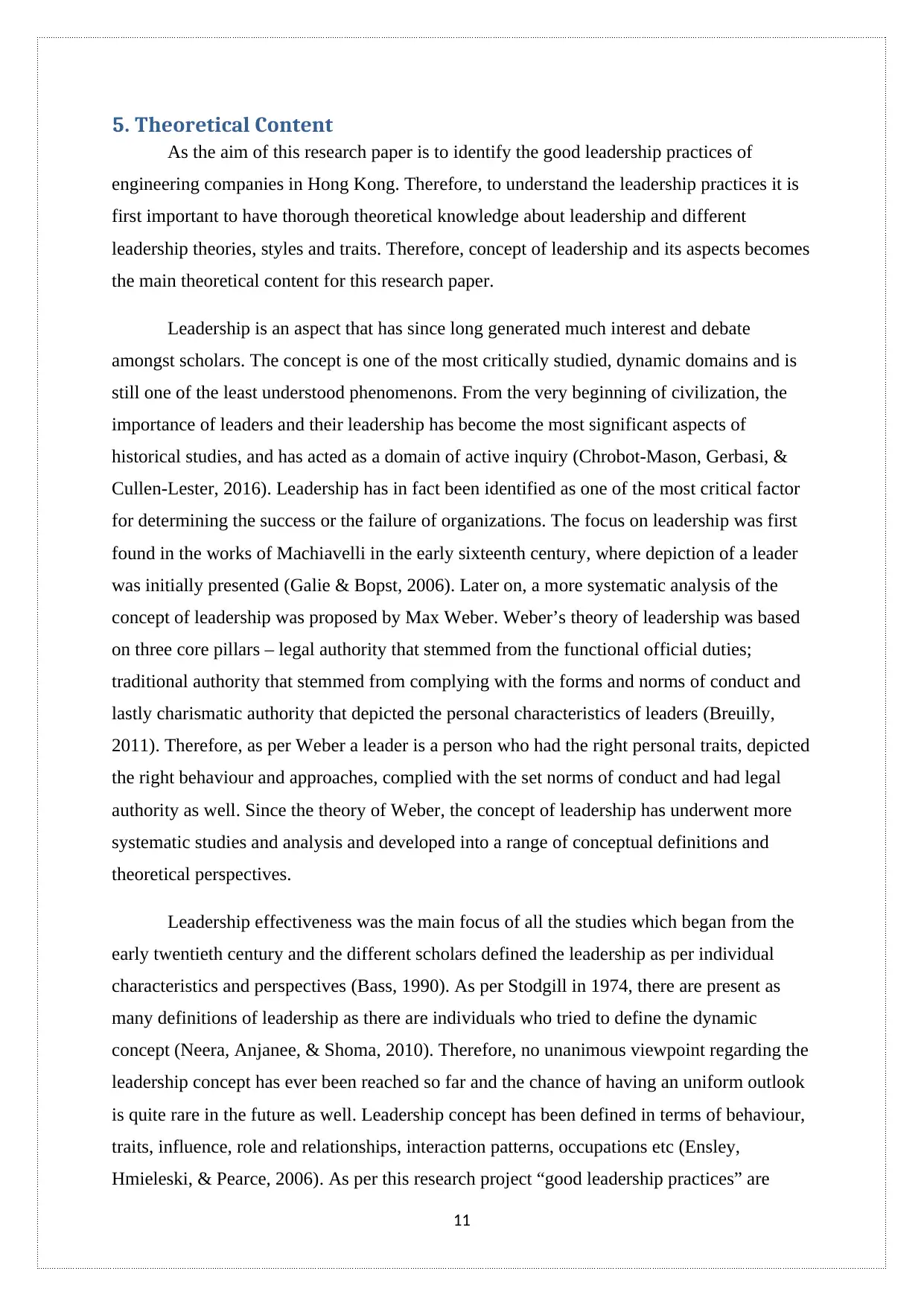
5. Theoretical Content
As the aim of this research paper is to identify the good leadership practices of
engineering companies in Hong Kong. Therefore, to understand the leadership practices it is
first important to have thorough theoretical knowledge about leadership and different
leadership theories, styles and traits. Therefore, concept of leadership and its aspects becomes
the main theoretical content for this research paper.
Leadership is an aspect that has since long generated much interest and debate
amongst scholars. The concept is one of the most critically studied, dynamic domains and is
still one of the least understood phenomenons. From the very beginning of civilization, the
importance of leaders and their leadership has become the most significant aspects of
historical studies, and has acted as a domain of active inquiry (Chrobot-Mason, Gerbasi, &
Cullen-Lester, 2016). Leadership has in fact been identified as one of the most critical factor
for determining the success or the failure of organizations. The focus on leadership was first
found in the works of Machiavelli in the early sixteenth century, where depiction of a leader
was initially presented (Galie & Bopst, 2006). Later on, a more systematic analysis of the
concept of leadership was proposed by Max Weber. Weber’s theory of leadership was based
on three core pillars – legal authority that stemmed from the functional official duties;
traditional authority that stemmed from complying with the forms and norms of conduct and
lastly charismatic authority that depicted the personal characteristics of leaders (Breuilly,
2011). Therefore, as per Weber a leader is a person who had the right personal traits, depicted
the right behaviour and approaches, complied with the set norms of conduct and had legal
authority as well. Since the theory of Weber, the concept of leadership has underwent more
systematic studies and analysis and developed into a range of conceptual definitions and
theoretical perspectives.
Leadership effectiveness was the main focus of all the studies which began from the
early twentieth century and the different scholars defined the leadership as per individual
characteristics and perspectives (Bass, 1990). As per Stodgill in 1974, there are present as
many definitions of leadership as there are individuals who tried to define the dynamic
concept (Neera, Anjanee, & Shoma, 2010). Therefore, no unanimous viewpoint regarding the
leadership concept has ever been reached so far and the chance of having an uniform outlook
is quite rare in the future as well. Leadership concept has been defined in terms of behaviour,
traits, influence, role and relationships, interaction patterns, occupations etc (Ensley,
Hmieleski, & Pearce, 2006). As per this research project “good leadership practices” are
11
As the aim of this research paper is to identify the good leadership practices of
engineering companies in Hong Kong. Therefore, to understand the leadership practices it is
first important to have thorough theoretical knowledge about leadership and different
leadership theories, styles and traits. Therefore, concept of leadership and its aspects becomes
the main theoretical content for this research paper.
Leadership is an aspect that has since long generated much interest and debate
amongst scholars. The concept is one of the most critically studied, dynamic domains and is
still one of the least understood phenomenons. From the very beginning of civilization, the
importance of leaders and their leadership has become the most significant aspects of
historical studies, and has acted as a domain of active inquiry (Chrobot-Mason, Gerbasi, &
Cullen-Lester, 2016). Leadership has in fact been identified as one of the most critical factor
for determining the success or the failure of organizations. The focus on leadership was first
found in the works of Machiavelli in the early sixteenth century, where depiction of a leader
was initially presented (Galie & Bopst, 2006). Later on, a more systematic analysis of the
concept of leadership was proposed by Max Weber. Weber’s theory of leadership was based
on three core pillars – legal authority that stemmed from the functional official duties;
traditional authority that stemmed from complying with the forms and norms of conduct and
lastly charismatic authority that depicted the personal characteristics of leaders (Breuilly,
2011). Therefore, as per Weber a leader is a person who had the right personal traits, depicted
the right behaviour and approaches, complied with the set norms of conduct and had legal
authority as well. Since the theory of Weber, the concept of leadership has underwent more
systematic studies and analysis and developed into a range of conceptual definitions and
theoretical perspectives.
Leadership effectiveness was the main focus of all the studies which began from the
early twentieth century and the different scholars defined the leadership as per individual
characteristics and perspectives (Bass, 1990). As per Stodgill in 1974, there are present as
many definitions of leadership as there are individuals who tried to define the dynamic
concept (Neera, Anjanee, & Shoma, 2010). Therefore, no unanimous viewpoint regarding the
leadership concept has ever been reached so far and the chance of having an uniform outlook
is quite rare in the future as well. Leadership concept has been defined in terms of behaviour,
traits, influence, role and relationships, interaction patterns, occupations etc (Ensley,
Hmieleski, & Pearce, 2006). As per this research project “good leadership practices” are
11
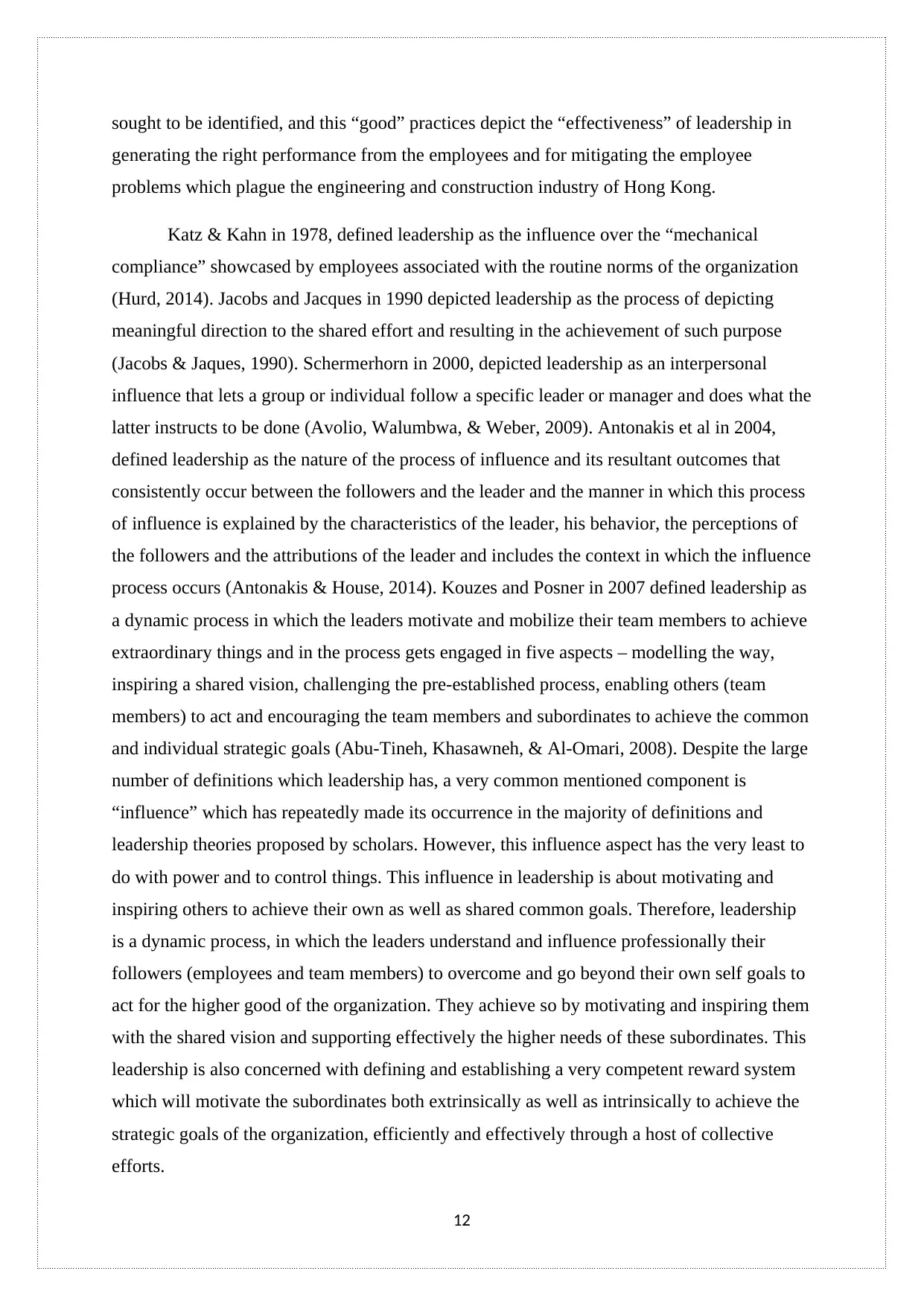
sought to be identified, and this “good” practices depict the “effectiveness” of leadership in
generating the right performance from the employees and for mitigating the employee
problems which plague the engineering and construction industry of Hong Kong.
Katz & Kahn in 1978, defined leadership as the influence over the “mechanical
compliance” showcased by employees associated with the routine norms of the organization
(Hurd, 2014). Jacobs and Jacques in 1990 depicted leadership as the process of depicting
meaningful direction to the shared effort and resulting in the achievement of such purpose
(Jacobs & Jaques, 1990). Schermerhorn in 2000, depicted leadership as an interpersonal
influence that lets a group or individual follow a specific leader or manager and does what the
latter instructs to be done (Avolio, Walumbwa, & Weber, 2009). Antonakis et al in 2004,
defined leadership as the nature of the process of influence and its resultant outcomes that
consistently occur between the followers and the leader and the manner in which this process
of influence is explained by the characteristics of the leader, his behavior, the perceptions of
the followers and the attributions of the leader and includes the context in which the influence
process occurs (Antonakis & House, 2014). Kouzes and Posner in 2007 defined leadership as
a dynamic process in which the leaders motivate and mobilize their team members to achieve
extraordinary things and in the process gets engaged in five aspects – modelling the way,
inspiring a shared vision, challenging the pre-established process, enabling others (team
members) to act and encouraging the team members and subordinates to achieve the common
and individual strategic goals (Abu-Tineh, Khasawneh, & Al-Omari, 2008). Despite the large
number of definitions which leadership has, a very common mentioned component is
“influence” which has repeatedly made its occurrence in the majority of definitions and
leadership theories proposed by scholars. However, this influence aspect has the very least to
do with power and to control things. This influence in leadership is about motivating and
inspiring others to achieve their own as well as shared common goals. Therefore, leadership
is a dynamic process, in which the leaders understand and influence professionally their
followers (employees and team members) to overcome and go beyond their own self goals to
act for the higher good of the organization. They achieve so by motivating and inspiring them
with the shared vision and supporting effectively the higher needs of these subordinates. This
leadership is also concerned with defining and establishing a very competent reward system
which will motivate the subordinates both extrinsically as well as intrinsically to achieve the
strategic goals of the organization, efficiently and effectively through a host of collective
efforts.
12
generating the right performance from the employees and for mitigating the employee
problems which plague the engineering and construction industry of Hong Kong.
Katz & Kahn in 1978, defined leadership as the influence over the “mechanical
compliance” showcased by employees associated with the routine norms of the organization
(Hurd, 2014). Jacobs and Jacques in 1990 depicted leadership as the process of depicting
meaningful direction to the shared effort and resulting in the achievement of such purpose
(Jacobs & Jaques, 1990). Schermerhorn in 2000, depicted leadership as an interpersonal
influence that lets a group or individual follow a specific leader or manager and does what the
latter instructs to be done (Avolio, Walumbwa, & Weber, 2009). Antonakis et al in 2004,
defined leadership as the nature of the process of influence and its resultant outcomes that
consistently occur between the followers and the leader and the manner in which this process
of influence is explained by the characteristics of the leader, his behavior, the perceptions of
the followers and the attributions of the leader and includes the context in which the influence
process occurs (Antonakis & House, 2014). Kouzes and Posner in 2007 defined leadership as
a dynamic process in which the leaders motivate and mobilize their team members to achieve
extraordinary things and in the process gets engaged in five aspects – modelling the way,
inspiring a shared vision, challenging the pre-established process, enabling others (team
members) to act and encouraging the team members and subordinates to achieve the common
and individual strategic goals (Abu-Tineh, Khasawneh, & Al-Omari, 2008). Despite the large
number of definitions which leadership has, a very common mentioned component is
“influence” which has repeatedly made its occurrence in the majority of definitions and
leadership theories proposed by scholars. However, this influence aspect has the very least to
do with power and to control things. This influence in leadership is about motivating and
inspiring others to achieve their own as well as shared common goals. Therefore, leadership
is a dynamic process, in which the leaders understand and influence professionally their
followers (employees and team members) to overcome and go beyond their own self goals to
act for the higher good of the organization. They achieve so by motivating and inspiring them
with the shared vision and supporting effectively the higher needs of these subordinates. This
leadership is also concerned with defining and establishing a very competent reward system
which will motivate the subordinates both extrinsically as well as intrinsically to achieve the
strategic goals of the organization, efficiently and effectively through a host of collective
efforts.
12
⊘ This is a preview!⊘
Do you want full access?
Subscribe today to unlock all pages.

Trusted by 1+ million students worldwide
1 out of 25
Related Documents
Your All-in-One AI-Powered Toolkit for Academic Success.
+13062052269
info@desklib.com
Available 24*7 on WhatsApp / Email
![[object Object]](/_next/static/media/star-bottom.7253800d.svg)
Unlock your academic potential
Copyright © 2020–2025 A2Z Services. All Rights Reserved. Developed and managed by ZUCOL.





